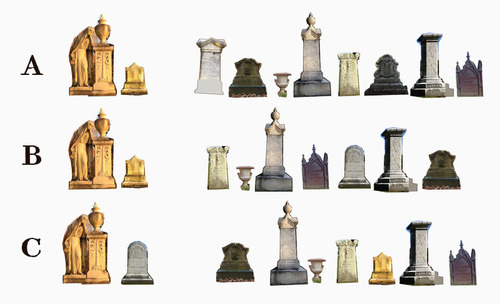The Making of a Spider Level, part 2
I seem to reinvent the wheel with each level, finding a different implementation process depending on the specific needs. In this case, because the shapes of these graves are such a huge part of the level design, I’m crafting the visuals in Photoshop first. (For levels where I can iterate over shapes and proportions, I implement straight into Unity with no graphics and when it plays well I bake out the outlines and fit art to them.)
I picked some of my favorite graves and arranged them in a few different combinations to consider which will be best.

One thing I am looking for is appealing composition. Since in Spider the camera is zoomed in such that you’ll only see two graves at a time, this is mostly about exploration as you move across the graveyard. For example I’d like to start with familiar shapes and evolve from there. On those grounds, I’m liking A or B.
But mostly I’m looking at the gameplay potential of these shapes. In Spider, the gameplay happens between surfaces the spider collides with. So what’s important is the negative space created by different grave profiles adjacent to each other.

Even more specifically, what to look for are surface normals that face (within a generous tolerance) other surface normals, because those are the spots the spider can connect a thread between. That’s why I like graves like the one with a triangle on top, or graves that have protruding bases or overhangs – they help provide planes that face other planes.

The spider can draw threads between planes that face other planes.
Using these criteria, I can evaluate A, B, and C for gameplay potential. In A, I don’t like the two graves to the left of the urn which create a gradual cascade from left to right; that’s going to lead players to start webs which are impossible to finish, so we’re better off without the leftmost grave. A also has a couple same-height graves adjacent to each other, which doesn’t add any options over adjacent different-height graves. Lastly A has more graves, which increases production burden and risks the level rambling on and on. As mentioned last time, each level in Spider changes when time and weather change in the real world. If we want players to replay levels, we should keep them short!

B has at least two spots where the spider can make strong webs, a new feature in this Spider game which incentivizes the player to make larger, more complicated webs to trap the hardest insects. C has them, too, but it looks like A only has one.
B and C also share some features I like, including the grave with the three points on top leaning toward a taller grave and the grave with scooped sides a bit apart from a tall grave. In C, the triangle-top grave is with the main group, whereas it’s set apart in B. This is an aesthetics-vs-gameplay consideration. Its positioning in C is good for web creation, but it’s an unfamiliar grave shape right where I want the spider to start.
I should mention it took quite a while to develop these heuristics. Whenever Tiger Style invents a new type of gameplay, I’m at a loss about how to build levels until I experiment a lot and get the hang of what constructions leads to what results. Lots of levels get thrown out along the way!
Ultimately, I’m going with B. On top of everything else, it best appeals to my instincts and looks most like the graveyards I’m drawing inspiration from. Still in Photoshop, I flesh out my crude composition with decaying nature and some stuff we haven’t talked about yet.

If you have any questions, just ask them in the comments section.
